The Asteroid Belt

Late in the 1700's, astronomers were looking for a planet which should have been located between Mars and Jupiter. Why were they thinking a planet must be there? Because of something called the Titius-Bode Rule. It's a mathematical formula that was developed over time during the 18th century. Here is the chart:
| Planet |
Bode equation |
Bode Number |
AU from sun |
| Mercury |
(0+4) / 10 |
0.4 |
0.387 |
| Venus |
(3+4) / 10 |
0.7 |
0.723 |
| Earth |
(6+4) / 10 |
1.0 |
1.00 |
| Mars |
(12+4) / 10 |
1.6 |
1.52 |
| ? |
(24+4) / 10 |
2.8 |
? |
| Jupiter |
(48+4) / 10 |
5.2 |
5.20 |
| Saturn |
(96+4) / 10 |
10.0 |
9.54 |
| Uranus |
(192+4 / 10 |
19.6 |
19.18 |
If you look at the Bode equation, you will see, in the parentheses, the first number is a 0 for Mercury, a 3 for Venus, and then each one doubles the last one. Adding four and then dividing by ten gives a "Bode Number" which closely approximates the Astronomical Units each body is from the sun. Thus, mathematically, there existed a large gap between Mars and Jupiter and it was there they were looking for another planet. On the first of January, 1801, a Sicilian astronomer/monk, Guiseppe Piazzi, was mapping the stars and noticed a 6th magnitude star that moved over several nights. He contacted Johann Bode, the direction of the Berlin Observatory, who was looking for a missing planet. For most of the year the object was too near the sun to see, but it was found again on December 31 of that year, and was named Ceres. Ceres orbits the sun once every 4.6 Earth years and is 2.77 AU distant from it. That appeared to be what they were looking for. However, in 1802, a few months later, Heinrich Olbers noticed another faint object (Pallas) in that range. Then more were discovered: Juno in 1804 and Vestain 1807. It was not until 1891, though, that Max Wolf, tracking stars with photographic plates, found the area in question was jammed with short tracks. He counted 228 small objects, and called them the "Vermin of the Skies."
We now know there are over two million asteroids. The large ones have names: the four named above have diameters over 300 km (190 miles). Those four comprise about half the mass of the entire asteroid belt. Thirty have diameters between 200 and 300 km (125-190 miles), two hundred have diameters larger than 100 km (63 miles), and about 1.9 million are around 1 km across (about 2/3 of a mile). They orbit he sun at a distance which ranges from 2.0 - 3.5 AU. All 2 million asteroids are numbered according to the order of their discovery. So there is 1 Ceres, 2 Pallas, 3 Juno, 4 Vesta, etc. all theway up to the 2 millionth asteroid.
Ceres was considered a small planet from 1801 until the 1860s. Then it was defined simply as one of the asteroids. Now it is considered a dwarf planet again. We will find out more about it soon, as we have a spacecraft approaching it, and we are getting photographs back now (February 26, 2015). Ceres has a diameter of 594 miles. Its surface is rocky, probably with some ice, and there seems to be some evidence of ice volcanoes. Ceres is a carbonaceous asteroid.
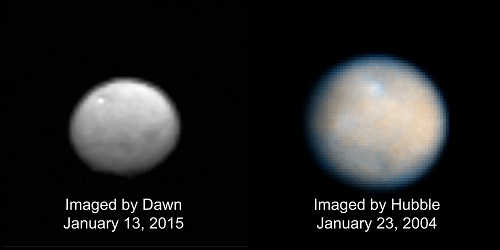
In January, as you can see on the left, above, there was a white spot noticed. A picture taken February 25, 2015, below, shows that white spot which has astronomers quite puzzled. Is it an active volcano? We will have to wait to find out. There is evidence of volcanic activity as this asteroid has a very thin watery atmosphere.
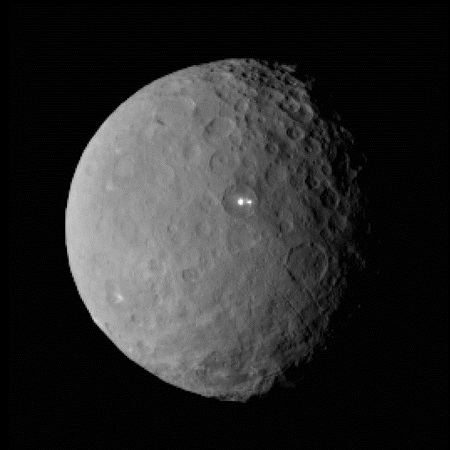
There are asteroids which do not circle in the main belt between Mars and Jupiter. As the first illustration shows, a number of them have been captured by Jupiter and are called the Trojan Asteroids, circling in Jupiter's orbit. Another smaller group seem to have escaped entirely and are called "earth-crossing asteroids." They are also referred to as NEA's or "near earth asteroids." There are three groups of these that we are aware of. The first two are the Aten Group and the Apollo Group. They orbit from the Asteroid Belt in towards the sun, then swing around the sun and back to the Asteroid Belt. Occasionally Earth crosses their paths just as they are circling toward the sun or back to the Asteroid Belt. They are considered a hazard to Earth at those times. The close approaches we have had recently have been from small members of these groups. The third group of NEA's orbit between Mars and Earth. This is the Amor Group. They are also considered to be hazardous to Earth. Astronomers are spending huge amounts of money trying to plot the orbits of these asteroids to find if one will hit us.
There are three main types of asteroids: stony, metallic (nickel/iron), and dark (also referred to as carbonaceous). There are a few of a fourth type called 'stony-irons,' as well. Ceres is a stony asteroid.
|
|
| Vesta, one side. The dark area at the bottom is part of a huge basin. Vesta has a large iron core surrounded by rock.. Vesta is part of the main belt between Mars and Jupiter. |
Vesta, the other side. The "lump" is at the opposite side from the large basin on the bottom of the left photograph. |
|
|
| Eros, asteroid #433, 22 miles long, solid stone. Eros is in the Amor Group, looping the sun. |
Itokawa, asteroid #25143, a stony rubble pile, less than half a mile long. It is in the Apollo Group, also looping the sun. |
|
|
| Ida, asteroid #243, 36 miles long, with its own tiny moon, Dactyl. Ida is a stony-iron asteroid. Ida is a main belt asteroid. |
Lutetia,asteroid #21, 75 miles long, nickel/iron with some stone. It is a main belt asteroid. |
|
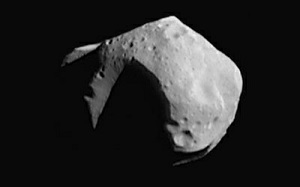 |
| Asteroid 2004 BL86, which safely flew past Earth on Jan. 26, 2015. It is 1100 feet across. It has its own small moon (the light dot), about 230 feet across. It is an iron and rock asteroid, like Vesta, and belongs to the Apollo Group.. Its official number is 357439, but it has not been given a name. |
Asteroid Mathilde, #253, is carbonaceous, and is 36 by 29 miles big. The giant crater in the shadow is about 12.5 miles across and estimated to be up to six miles deep. |
The main asteroid belt, between Mars and Jupiter, is not a lot of uniformly scattered rocks of various sizes. First of all, despite diagrams of the belt, the asteroids are so widely scattered that if you were on one you probably would not see another one. In addition, the main belt is actually three rings of asteroids separated by Kirkwood Gaps, so named for the scientist who discovered them. Interestingly, there appears to be a mathematical connection with Jupiter regarding the orbital rates of these rings. One theory is that it is these orbital resonances which cause the Kirkwood Gaps.
Wikipedia explains the resonance well: The main or core population of the asteroid belt is sometimes divided into three zones, based on the most prominent Kirkwood gaps. Zone I lies between the 4:1 resonance (2.06 AU) and 3:1 resonance (2.5 AU) Kirkwood gaps. Zone II continues from the end of Zone I out to the 5:2 resonance gap (2.82 AU). Zone III extends from the outer edge of Zone II to the 2:1 resonance gap (3.28 AU).
The asteroid belt may also be divided into the inner and outer belts, with the inner belt formed by asteroids orbiting nearer to Mars than the 3:1 Kirkwood gap (2.5 AU), and the outer belt formed by those asteroids closer to Jupiter's orbit. (Some authors subdivide the inner and outer belts at the 2:1 resonance gap (3.3 AU), whereas others suggest inner, middle, and outer belts.
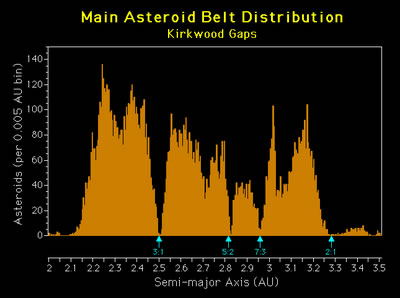
That the gaps are there is not in doubt. (the height of the orange peaks above is somewhat confusing as the Y axis indicates these are the numbers per unit of space. There is a lot more space in the outer ring! The actual numbers, however, are much higher than the other areas.) However, attributing them to Jupiter's gravitational pull does not explain the fact that the asteroids in each section, or ring, are composed of different materials. The outer region, closest to Jupiter, involves about 75% of the known asteroids, and they are the carbonaceous asteroids (C type), dark in color.
The small peak between the outer ring peak (on the right side of the chart) and the middle is a section comprised of the 'stony-irons.'
The middle section section only seems to have about 8% of the known asteroids circling there. They are the M-type, or metallic asteroids. They are often reddish in color.
The innermost section are the S-type asteroids, comprising about 17 % of the asteroids in the main belt. They are the silicaceous, or stony, asteroids and their colors range from a sort of green to a reddish.
There are other asteroids which do not fit neatly into those three categories. Vesta is one. Again, a Wikipedia article has an interesting observation:
One mystery of the asteroid belt is the relative rarity of V-type, or basaltic asteroids. Theories of asteroid formation predict that objects the size of Vesta or larger should form crusts and mantles, which would be composed mainly of basaltic rock, resulting in more than half of all asteroids being composed either of basalt or olivine. Observations, however, suggest that 99 percent of the predicted basaltic material is missing.Until 2001, most basaltic bodies discovered in the asteroid belt were believed to originate from the asteroid Vesta (hence their name V-type). However, the discovery of the asteroid 1459 Magnya revealed a slightly different chemical composition from the other basaltic asteroids discovered until then, suggesting a different origin. This hypothesis was reinforced by the further discovery in 2007 of two asteroids in the outer belt, 7472 Kumakiri and (1057) 1991 RY16, with differing basaltic composition that could not have originated from Vesta. These latter two are the only V-type asteroids discovered in the outer belt to date.
Some of the asteroids in all areas, including Jupiter's Trojans, have members either circling each other -- binaries -- or have little moons circling them. This picture is of Antiope, a binary in the outer main belt. It is being pictured against the streaking star tracks behind it (actually, the stars are still, but keeping focus on the moving asteroid pair makes it look like the stars are moving in the background).
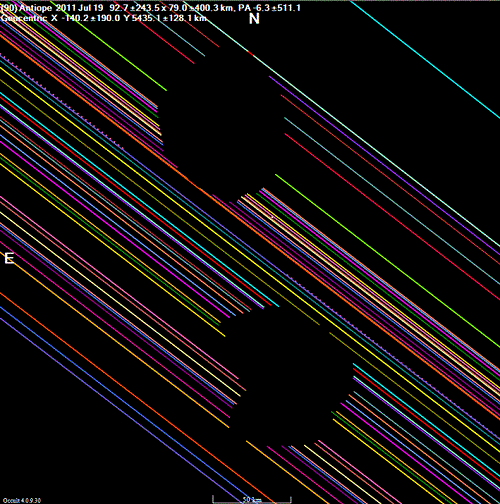
We are aware of about 250 binary systems and over 150 asteroids with their own circling moons. Some have more than one moon. Elektra 130, a large main belt outer asteroid, has four moons. Elektra is 135 miles across at its longest point. Although, astronomicaly, 135 miles is almost nothing, for an asteroid, it's big.
Asteroids can, and do, collide with each other. When this happens, more break-ups occur and some pieces can go flying out into space, away from the belt. Occasionally we can see one as a meteor blazing across the sky. This is quite different from the annual meteor showers we know are coming. Asteroid meteor are not predictable, and so referred to as "sporadic." (A meteor becomes a meteorite when it hits the earth's surface.)
August 13, 2014 -- It has been found that Near Earth Asteroid 1950DA rotates extremely quickly. "In fact, the rotation is so fast at its equator that if an astronaut were to attempt to stand on this surface, he or she would fly off into space unless he or she were somehow anchored... Previous research has shown that asteroids are loose piles of rubble held together by gravity and friction. However, the University of Tennessee team found that 1950DA is spinning so quickly that it seemingly defies these forces."